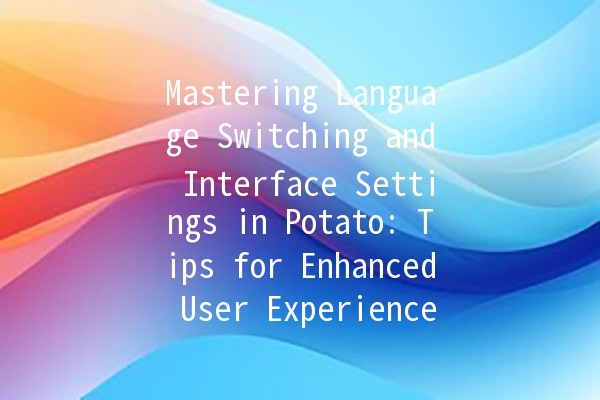Understanding Language Switching in Potato
Potato is a versatile platform that allows users to customize their interface according to their language preferences. Language switching can enhance user experience significantly, making it more intuitive for diverse user groups. Employing techniques for efficient language switching can empower users to navigate seamlessly through the Potato interface.
Why Language Switching Matters
Language switching is vital for creating an inclusive environment. It allows nonnative speakers to use the platform more comfortably, thereby increasing user satisfaction and engagement. Furthermore, offering multilingual support can broaden your audience base, fostering a global community.
Tips for Effective Language Switching in Potato

Here are five practical tips for enhancing productivity through effective language switching and interface settings in Potato:
Explanation
Adjusting language settings to fit individual preferences can help users navigate the Potato interface more comfortably. By customizing language options, users can ensure that all labels, buttons, and instructions are displayed in their preferred language.
Practical Application
To customize your language settings in Potato:
Go to the user settings menu.
Select the ‘Language’ option.
Choose your preferred language from the dropdown menu.
Save your settings and refresh the interface to apply changes.
By doing this, users can directly interact with the content in a language they understand best, improving their overall experience.
Explanation
Language packs are collections of translations that cater to specific languages within the Potato platform. Using language packs can enhance efficiency, as they ensure that all elements are uniformly translated.
Practical Application
To utilize language packs:
Navigate to the settings page.
Look for the ‘Language Packs’ section.
Download and install the necessary language packs.
Activate the desired pack through the settings menu.
This not only simplifies the interface but also increases productivity as users find it easier to perform tasks in their selected language.
Explanation
Creating shortcut keys allows users to switch languages instantly, saving time and making the process more fluid. Custom shortcut keys can lead to improved workflow and decreased frustration during tasks.
Practical Application
To set up shortcut keys in Potato:
Access the 'Keyboard Shortcuts’ settings in the user interface.
Assign custom key combinations for your chosen languages.
Test the shortcuts to ensure they work seamlessly.
This feature allows users to toggle between languages quickly without disrupting their workflow.
Explanation
Beyond language settings, customizing the interface to fit individual needs can significantly enhance productivity. Factors such as layout, theme, and font size can all be adjusted to improve usability.
Practical Application
To customize your interface:
Go to the 'Appearance' settings in your profile.
Choose from various themes or layouts that suit your preferences.
Adjust font size and other accessibility options if needed.
By tailoring the interface to suit personal preferences, users can create a more efficient and comfortable working environment.
Explanation
Offering constructive feedback to the developers regarding language support and interface usability can help improve the overall platform. Engaging in user communities or forums can facilitate discussions around necessary updates or enhancements.
Practical Application
To provide feedback:
Participate in community forums or feedback sections within the Potato platform.
Share your experiences and suggestions related to language support.
Encourage fellow users to do the same.
This collective feedback can lead to improvements, resulting in a more robust and userfriendly environment for all users.
Common Questions About Language Switching and Interface Settings in Potato
Changing the language in Potato can be done easily through the user settings menu. After selecting your preferred language from the dropdown list, make sure to save your changes and refresh the interface to see the updates.
Yes, users can switch languages at any time. By utilizing assigned shortcut keys or accessing the language settings, you can quickly change the language as needed without disrupting your workflow.
Yes, Potato offers various language packs that can be downloaded from the settings menu. Once installed, users can activate their desired language pack to ensure all content is translated accurately.
If your preferred language is not available, providing feedback to the Potato development team is crucial. Express your interest in adding more languages, and they may consider it for future updates.
User feedback can typically be submitted through community forums or feedback forms located within the Potato platform. Be specific about your experience and suggestions to make them more impactful.
To reset your language settings back to default, go to the settings menu, navigate to the language section, and select the default language option. This will restore the original interface settings.
Incorporating these strategies for language switching and interface customization in Potato can significantly enhance user productivity and satisfaction. By understanding the tools available and how to maximize them, users can create a tailored experience that meets their individual needs. With the right approach, navigating through multiple languages can become an effortless and enriching task.